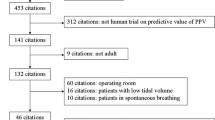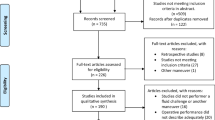Abstract
This systematic review aims to summarize the published data on the reliability of pulse pressure variation (PPV) and stroke volume variation (SVV) to predict fluid responsiveness in an open-chest setting during cardio-thoracic surgery. The analysis included studies reporting receiver operating characteristics or correlation coefficients between PPV/SVV and change in any hemodynamic variables after a fluid challenge test in open-chest conditions. The literature search included seven studies. Increase in cardiac index and stroke volume index after a fluid challenge were the most adopted end-point variables. PPV and SVV showed similar area under the receiver operating characteristic curve values but high heterogeneity among studies. Cardiac and thoracic studies did not differ between PPV/SVV pooled area under the receiver operating characteristic curve. Studies exploring correlation between dynamic indices and end-point variable increase after fluid challenge showed conflicting results. The great heterogeneity between studies was due to small sample size and differences among protocol designs (different monitor devices, mechanical ventilation settings, fluid challenge methodologies, surgical incisions, and end-point variables). PPV and SVV seem to be inaccurate in predicting fluid responsiveness in an open-chest setting during cardio-thoracic surgery. Given the high heterogeneity of published data, more studies are needed to define the role of PPV/SVV in this context.

Similar content being viewed by others
References
Cannesson M, Aboy M, Hofer CK. Pulse pressure variation: where are we today? J Clin Monit Comput. 2011;25:45–56.
Lobo SM, Mendes CL, Rezende E, Dias FS. Optimizing perioperative hemodynamics: what is new? Curr Opin Crit Care. 2013;19:346–52.
Hamilton MA, Cecconi M, Rhodes A. A systematic review and meta-analysis on the use of preemptive hemodynamic intervention to improve postoperative outcomes in moderate and high-risk surgical patients. Anesth Analg. 2011;112:1392–402.
Aya HD, Cecconi M, Hamilton MA, Rhodes A. Goal-directed therapy in cardiac surgery: a systematic review and meta-analysis. Br J Anaesth. 2013;110:510–7.
Zhang J, Chen CQ, Lei XZ, Feng ZY, Zhu SM. Goal-directed fluid optimization based on stroke volume variation and cardiac index during one-lung ventilation in patients undergoing thoracoscopy lobectomy operations: a pilot study. Clinics (Sao Paulo). 2013;68:1065–70.
Reuter DA, Goresch T, Goepfert MSG, Whildirt SM, Kilger E, Goetz AE. Effects of mid-line thoracotomy on the interaction between mechanical ventilation and cardiac filling during cardiac surgery. Br J Anaesth. 2004;92:808–13.
Lorne E, Mahjoub Y, Zogheib E, Debec G, Ben Ammar A, Trojette F, Dehedin B, Remadi JP, Caus T, Dupont H. Influence de l’ouverture du thorax par sternotomie sur les variations respiratoires de la pression pulsé. Ann Fr Anesth Reanim. 2011;30:117–21.
Rex S, Schalte G, Schroth S, De Waal EEC, Metzelder S, Overbeck Y, Rossaint R, Buhre W. Limitations of arterial pulse pressure variation and left ventricular stroke volume variation in estimating cardiac pre-load during open heart surgery. Acta Anaesthesiol Scand. 2007;51:1258–67.
Piccioni F, Bernasconi F, Tramontano G. A systematic review and meta-analysis of pulse pressure variation and stroke volume variation to predict fluid responsiveness during cardiac and thoracic surgery. PROSPERO 2015:CRD42015028071. http://www.crd.york.ac.uk/PROSPERO/display_record.asp?ID=CRD42015028071. Accessed 26 Mar 2016.
Moher D, Liberati A, Tetzlaff J, Altman DG. Preferred reporting items for systematic reviews and meta-analyses: the PRISMA statement. J Clin Epidemiol. 2009;62:1006–12.
National Heart, Lung and Blood Institute of the American National Institute of Health. https://www.nhlbi.nih.gov/health-pro/guidelines/in-develop/cardiovascular-risk-reduction/tools/before-after. Accessed 15 Sept 2015.
Wyffels PAH, Sergeant P, Wouters PF. The value of pulse pressure and stroke volume variation as predictors of fluid responsiveness during open chest surgery. Anaesthesia. 2010;65:704–9.
Hozo SP, Djulbegovic B, Hozo I. Estimating the mean and variance from the median, range, and the size of a sample. BMC Med Res Methodol. 2005;5:13.
Reuter DA, Goepfert MSG, Goresch T, Schmoeckel M, Kilger E, Goetz AE. Assessing fluid responsiveness during open chest conditions. Br J Anaesth. 2005;94:318–23.
De Waal EEC, Rex S, Kruitwagen CLJJ, Kalkman CJ, Buhre WF. Dynamic preload indicators fail to predict fluid responsiveness in open-chest conditions. Crit Care Med. 2009;37:510–5.
Suehiro K, Okutani R. Stroke volume variation as a predictor of fluid responsiveness in patients. J Cardiothorac Vasc Anesth. 2010;24:772–5.
Suehiro K, Okutani R. Influence of tidal volume for stroke volume variation to predict fluid responsiveness in patients undergoing one-lung ventilation. J Anesth. 2011;25:777–80.
Lee J, Jeon Y, Bahk JH, Gil NS, Hong DM, Kim JH, Kim HJ. Pulse pressure variation as a predictor of fluid responsiveness during one-lung ventilation for lung surgery using thoracotomy: randomised controlled study. Eur J Anaesthesiol. 2011;28:39–44.
Fu Q, Zhao F, Mi W, Zhang H. Stroke volume variation fail to predict fluid responsiveness in patients undergoing pulmonary lobectomy with one-lung ventilation using thoracotomy. BioSci Trends. 2014;8:59–63.
Marik PE, Cavallazzi R, Vasu T, Hirani A. Dynamic changes in arterial waveform derived variables and fluid responsiveness in mechanically ventilated patients: a systematic review of the literature. Crit Care Med. 2009;37:2642–7.
Kubitz JC, Annecke T, Kemming GI, Forkl S, Kronas N, Goetz AE, Reuter DA. The influence of positive end-expiratory pressure on stroke volume variation and central blood volume during open and closed chest conditions. Eur J Cardio-thoracic Surg. 2006;30:90–5.
De Backer D, Heenen S, Piagnerelli M, Koch M, Vincent JL. Pulse pressure variations to predict fluid responsiveness: influence of tidal volume. Intensive Care Med. 2005;31:517–23.
Reuter DA, Bayerlein J, Goepfert MSG, Weis FC, Kilger E, Lamm P, Goetz AE. Influence of tidal volume on left ventricular stroke volume variation measured by pulse contour analysis in mechanically ventilated patients. Intensive Care Med. 2003;29:476–80.
Haas S, Eichhorn V, Hasbach T, Trepte C, Kutup A, Goetz AE, Reuter DA. Goal-directed fluid therapy using stroke volume variation does not result in pulmonary fluid overload in thoracic surgery requiring one-lung ventilation. Crit Care Res Pract. 2012;2012:687018.
Kapoor PM, Kakani M, Chowdhury U, Choudhury M, Lakshmy R, Kiran U. Early goal-directed therapy in moderate to high-risk cardiac surgery patients. Ann Card Anaesth. 2008;11:27–34.
Acknowledgments
The authors wish to thank Alexa Ahern for linguistic revision of this paper.
Author information
Authors and Affiliations
Corresponding author
Ethics declarations
Conflict of interest
None.
Rights and permissions
About this article
Cite this article
Piccioni, F., Bernasconi, F., Tramontano, G.T.A. et al. A systematic review of pulse pressure variation and stroke volume variation to predict fluid responsiveness during cardiac and thoracic surgery. J Clin Monit Comput 31, 677–684 (2017). https://doi.org/10.1007/s10877-016-9898-5
Received:
Accepted:
Published:
Issue Date:
DOI: https://doi.org/10.1007/s10877-016-9898-5




